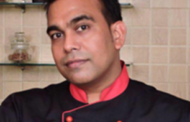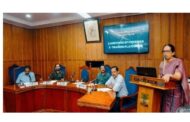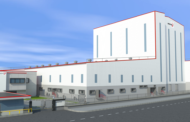“Freshwater aquaculture holds key to the growth of the fisheries sector in the country. Today we are producing about 6.5 million tonnes fishes from freshwater aquaculture. If we want to achieve the target of 16 million tonnes in the next five years, then we need to adopt innovative approaches”, says Dr. Joykrushna Jena, Deputy Director-General, Fisheries
Sciences, ICAR in a special interview with SMART AGRIPOST.
Q. What are the emerging challenges in the fisheries sector?
Ans. If you look at the fish production trends in the country over these years, it has been showing consistent annual growth rate of 5-6 percent during last three decades. Our production today (2017-18) is about 12.6 million tonnes, which is 0.8 million tonnes higher than the last year. If you see the export also, it has been growing at significantly faster rate,
and last year’s growth rate is over 20 percent higher than the previous year.
Last year the export of marine products was US$ 7 billion, i.e. over Rs 45,000, all time high for the fisheries sector. But, yes there are several challenges which we need to address. If we want to achieve the same growth rate of 6-7 percent we have to have a steady increase in our production and productivity from the aquaculture sector. That too freshwater aquaculture holds the key. Today we are producing about 6.5 million tonnes of fish from freshwater aquaculture. If we want to achieve the target production of 16 million tonnes in next 5 years, then probably we need to have several approaches.
In spite of the fact that we have about 2.4 million ha of water area in the form of ponds and tanks for freshwater aquaculture, today about 30-35 percent of this available pond area are either under some sort of extensive farming or not even put to economic use. So our effort has to be bringing these unutilized areas which are at the lowest level of utilization to some
sort of a scientific or intensive farming. So, we have to have different approaches.
Q. How do you think to realize the vision of ICAR- ‘Fish for All for Ever’?
Ans. ‘Fish for All for Ever’ is not only the vision of ICAR; this is also the vision for the whole country. Today we don’t consider fish only as a protein food or a nutrition rich food. We consider fish as a health food.
In this context we wish that the fish which is available today is also available tomorrow and it should be available for everyone. We are looking at sustainable growth in production. We are not only looking at increasing production only from the freshwater sector but also brackish water as well as the marine sectors.
Today along with the production increase we are also giving emphasis on diversification. During last six decades we have been able to develop breeding and seed production technologies of over 60 species of important finishes and crustaceans. All these to a great extent have gone to the farmers’ level. A consumer also does not like to have the same fish
daily.
He wishes to have different fish on different day in different meals. In this context, the diversification is one of the important aspects and we are trying to bring more species of promise into the aquaculture systems. We wish in coming 15-20 years we can bring in another 30-40 species into aquaculture systems.
Q. What are the initiatives ICAR has taken to make fisheries sector sustainable?
Ans. Yes, ICAR is taking several initiatives. When we talk about diversification, just bringing new species is not enough. For example, when we talk of 60-100 species we need also feed, health management measures, we also need good quality seeds. In this direction we have several approaches. One approach is stock improvement, improvement of their traits, whether it is growth or disease resistance and so on and so forth. You may be aware about selective bred Rohu, called Jayanti. Till now we have reached 9 th generation of selective breeding and you would be happy to know that 17-18 percent higher growth response is achieved per generation.
Besides Rohu, we have also started this selective breeding programme for Catla as well as
freshwater prawn. In coming few years, we wish to take up similar programmes for other
important fish species and also for shrimps for faster growth and other traits. Secondly, as I
told, development of new feeds; or rather development of balanced feed for each of the
species depending on their requirement at different life stages. There are several species,
like catfishes which need to be grown under monoculture. You need to have specialized
feed for each of these catfish, whether it is pangasius or magur or any other catfish. But, on
the other hand, when you talk about carps, we grow 3-6 species in one pond under
polyculture system. In such case you can’t give different type of feed for different species
and you need to have a specific feed which will suit to all varieties of fish.
Health management is another important area. Over these years aquaculture has witnessed
huge economic loss because of several types of disease. You may be aware about the
persistent problem that the coastal shrimp farming sector in the country is experiencing
over last two decades due to disease like WSSV. Besides WSSV, today the shrimp farming
sector is subjected to serious threat of EHP, another important parasitic disease. Therefore,
all the time we need to be prepared enough to countering any new disease that may pose
threat in future. We have been working in all these directions, including health
management, nutrition, genetics and several other biotechnological aspects.
We have been able to develop the technology of fish milt cryopreservation. It is possible for
us now to take the milt of improved stocks to other distance places and use for improving
the stocks. For brackishwater aquaculture sector, we are trying to provide alternate option
to shrimp farming, i.e. complete farming packages for finfish species like seabass and
milkfish. Mariculture is another area; we have been giving emphasis during last 5-6 years.
Q. What are the opportunities available for fish entrepreneurs and what are schemes
government is providing?
Ans. At one point of time we could find the commercial fish farming only in Koleru lake
region of Andhra Pradesh and here and there in some other places. The situation has
changed so much during last one decade or so.
Commercial enterprise has now become so common in most of the states of the country.
People are going for very high intensive farming, and production levels of 10-15 tonnes in
case of carps or 20-25 tonnes in case of catfishes like pangasius have become very common.
Even in the coldwater region of northern India, where we have 3-4 months of cold period,
farmers are able to harvest 20 tonne of pangasius. Some of the farmers have invested good
amount for high intensive farming or super intensive farming, what is called as Recirculatory
Aquaculture System (RAS). Mainly in urban areas or peri-urban areas, where there is either
land shortage or land is expensive, entrepreneurs are coming up for initiating RAS.
But, we have to go a long way, because here is a system in which you can’t have a low value
specie like carp, since the cost of production would be relatively higher due to higher energy
inputs and higher capital investments. We need to have species which are of high value.
You will be happy to know that 3-4 tonne production is very common in these areas within a
period of just 4 months. Farmers have been able to get profit margin of somewhere around
Rs 3-4 lakh per acre. But, where there is more profit, there is more risk. We need to see that
farmers are also made aware about various challenges associated with the activity and
upgrade their skills. Although ICAR does not provide any scheme, Government of India has
several schemes. NFDB, Hyderabad provides assistance for different projects and
programmes.
Q. This sector is facing acute shortage of skilled manpower. Have you developed any
curriculum, syllabus or system so that people can be skilled?
Ans. This is an important area we must focus not only for next one year or two, but
consistently we need to conduct skill development programmes. Over the years we have
been organizing number of training programmes through all our eight ICAR fisheries
research institutes and their regional centres.
However, considering the requirement our uptake is quite low. For example, one institute
may conduct 10-12 programmes in a year which means at best 300-400 farmers can be
trained by each institute. Country like India with such huge population, requirement of
training can’t be met by us. We had discussion meetings with NFDB where this point was
vividly discussed and it was agreed that we would intensify this skill development
programme in all our ICAR Institutes.
We sincerely think every year at least 8000-10000 farmers may be trained through ICAR
institute with funding support of NFDB. Besides this also we have programmes with the
Skills Council of India. Few areas have been identified after discussions with SCI where our
institutes are also involved in such skill development. One aspect is providing direct training
to the farmers and the other is Training to the trainers. Trained trainers can go back to their
respective places and train more number of farmers. We have also some certificate courses.
Q. If you see, climate change and over fishing have seriously jeopardized the sustainability
of the marine sector. What measures ICAR is taking in terms of research to make the
marine sector sustainable?
Ans. If you see the total capture fisheries trend in the globe in last 20 years, you will find,
there is no increase, rather it has remained almost stagnant somewhere around 90-95
million tonnes globally. If you see the capture fisheries from Indian coasts, in spite of all the
challenges of overfishing in our coastal waters, climate change and pollution in coastal
water, still our production has been on increasing trend. Today, we produce about 3.8
million tonne from the sea.
But the major focus of ours should be how to sustain this production, whatever we get
today. We have almost reached the optimum level. So we don’t have scope of increasing
much. Probably, we need to do is going little deeper. Our coastal waters almost have been
exploited to its potential and in some places have been over-exploited also. Challenges are
fishing in water beyond 50 metre depth, which we have not been able to do much. Because
we need deep sea vessels, more investment is necessary.
When you need to go into sea for one week to ten days duration, there has to be enough
ice, all the facilities inside the vessel for the people going inside the sea. In this context
Government of India has also come out with some of its programmes for providing funding
support for these deep sea vessels. Last two years government has been providing this
support in various states.
I am sure, in coming days, once we have more number of deep sea vessels, our production
from deep sea fishing will also increase. It is necessary that our fishermen are also given
adequate expertise on all safety measures when they go for deep sea fishing. We are taking
some steps for training these people who are going for deep sea fishing through our ICAR
institute at CIFT, Kochi as well as through CIFNET- a DADF institute. So both the
organisations have taken steps for organising more training programmes for making them
aware about the problems and difficulties in deep sea fishing and also educating them on
the safety measures.

For more aquaculture news, please visit https://aquapost.in/






